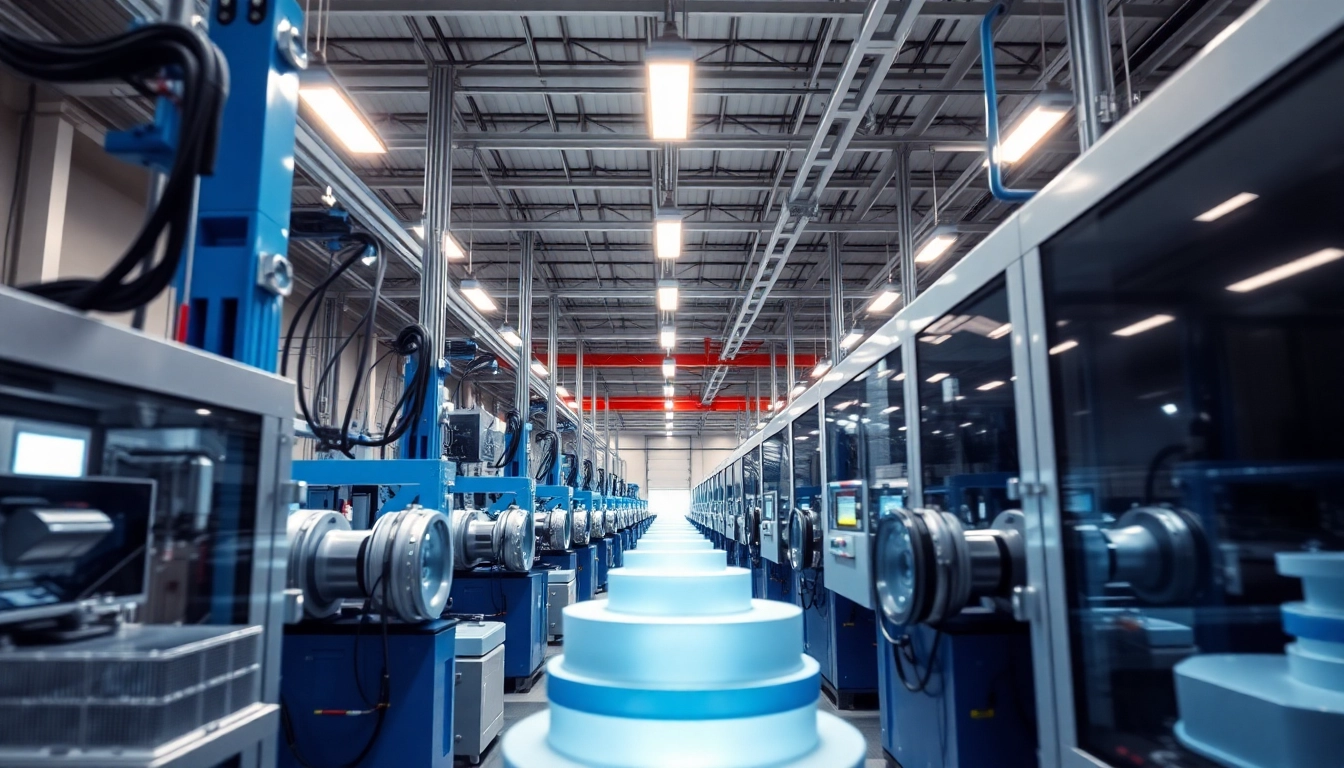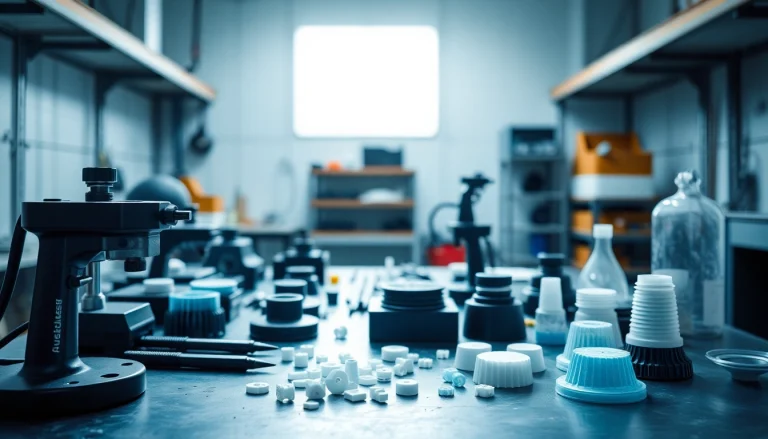Understanding Injection Molding: Basics and Benefits
Injection molding is a widely utilized manufacturing process that transforms raw materials into finished products, making it a cornerstone of modern manufacturing. The flexibility and efficiency of this method have solidified its place in various industries. An injection molding company can offer significant advantages in production speed, precision, and material savings. This section delves into the fundamentals of injection molding and the myriad benefits it brings to businesses seeking efficient manufacturing solutions.
What is Injection Molding?
Injection molding is a manufacturing process that involves the injection of molten material into a mold to create parts and products. The materials used can vary widely, but the most common are thermoplastics and thermosetting polymers. The process generally involves the following key steps:
- Material Preparation: Raw plastic pellets are fed into a hopper and heated until they liquefy.
- Injection: The molten material is injected into a closed mold under high pressure.
- Cooling: The material cools and solidifies within the mold, taking the shape of the desired product.
- Mold Opening and Ejection: Once cooled, the mold is opened, and the finished part is ejected.
This process is highly repeatable and allows for complex designs and tight tolerances, making it ideal for mass production. Its adaptability to various materials also contributes to the diversity of products that can be manufactured, from automotive parts to consumer goods.
Advantages of Using an Injection Molding Company
Utilizing the expertise of an injection molding company offers numerous advantages to businesses:
- Cost Efficiency: Mass production reduces the cost per unit, making it an economical choice for high-volume runs.
- High Precision: Injection molding produces parts with high dimensional accuracy, essential for many applications.
- Material Versatility: A vast range of materials can be used, enabling companies to tailor products to specific needs.
- Design Flexibility: Complex geometries can be created with ease, accommodating innovative design concepts.
- Reduced Waste: The process generates minimal waste compared to other manufacturing methods, contributing to sustainability efforts.
Common Applications in Various Industries
Injection molding is employed across a multitude of industries due to its versatility. Some typical applications include:
- Automotive: Components such as dashboards, bumpers, and interior fittings.
- Consumer Products: Items like toys, containers, and household goods.
- Medical Devices: Precision components for syringes, inhalers, and other devices.
- Electronics: Enclosures and housings for devices like smartphones and computers.
- Aerospace: Lightweight structural parts that meet strict regulations.
Choosing the Right Injection Molding Company
Selecting an injection molding partner is a significant decision that can impact production quality and efficiency. Understanding the key factors in this selection process can lead to a successful partnership.
Factors to Consider When Selecting a Partner
When choosing an injection molding company, consider the following criteria:
- Experience and Expertise: Look for a company with a proven track record in your industry.
- Capabilities: Ensure the company has the necessary technology and resources to meet your specific needs.
- Quality Assurance: Assess their quality control processes and certifications, such as ISO standards.
- Communication: Effective communication is essential for collaboration and project management.
- Location: Geographic proximity can affect lead times and shipping costs.
Key Questions to Ask Your Injection Molding Company
As you engage with potential partners, consider asking the following questions:
- What types of materials do you work with?
- Can you provide examples of similar projects you have completed?
- What are your lead times for prototyping and production?
- How do you handle design revisions during the process?
- What quality control measures do you implement?
Comparing Services and Capabilities
Not all injection molding companies offer the same range of services. Thus, evaluating their offerings is critical:
- Prototype Development: Some companies offer rapid prototyping services to bring designs to life quickly.
- Production Volume: Consider whether they can handle low-volume or high-volume runs based on your needs.
- Post-Processing Capabilities: Inquire about additional services such as assembly, finishing, or packaging.
Advanced Techniques in Injection Molding
The field of injection molding is continuously evolving, with new techniques and technologies emerging to enhance efficiency and product quality.
Latest Innovations in Injection Molding Technology
Some of the latest advancements in injection molding include:
- 3D Printing Integration: The combination of 3D printing and injection molding allows for rapid prototyping and complex designs.
- Multi-Material Molding: Technologies such as overmolding enable the production of parts using multiple materials, enhancing functionality.
- Smart Mold Technology: Utilization of IoT and sensors to monitor production in real-time for improved quality control.
- Biodegradable Materials: Increasing use of sustainable materials to meet environmental regulations and consumer demand.
Cost-Effective Strategies for Production
To maximize cost efficiency in injection molding, companies can adopt these strategies:
- Mold Optimization: Investing in high-quality, durable molds can reduce maintenance costs and downtime.
- Lean Manufacturing Principles: Implementing lean techniques can minimize waste and streamline processes.
- Material Selection: Choosing the right materials to match production needs can decrease costs and improve performance.
Sustainable Practices in Injection Molding
Sustainability is becoming increasingly important in manufacturing. To adopt sustainable practices, companies can:
- Recycle Materials: Use recycled plastics and implement a recycling program for waste generated during production.
- Energy Efficiency: Invest in energy-efficient machines and practices to reduce the carbon footprint.
- Sustainable Sourcing: Choose suppliers who prioritize sustainable production methods for raw materials.
Case Studies: Successful Partnerships with Injection Molding Companies
Examining real-world examples can provide insights into how businesses have successfully utilized injection molding partnerships.
How Companies Achieved Efficiency Through Injection Molding
Case studies illustrate how various companies have improved their operations:
- ABC Manufacturing: Reduced production costs by 30% by switching to an injection molding company that offered advanced automation technology.
- XYZ Tech: Enhanced product quality and reduced defects by 25% through a collaborative design process with their injection molding partner.
Real-World Applications and Success Stories
Many industries rely on injection molding for successful product outcomes:
- Medical Devices: A healthcare provider partnered with an injection molding company to produce high-precision surgical instruments, leading to improved patient outcomes.
- Consumer Electronics: A tech company utilized injection molding to manufacture customized enclosures for their new product line, achieving a faster go-to-market time.
Customer Testimonials: Boosting Manufacturing with Injection Services
Feedback from businesses provides insight into the effectiveness of injection molding:
“Working with [Injection Molding Company] has transformed our production capabilities. Their expertise helped us innovate our designs while reducing costs.” – John D., Operations Manager at Tech Innovations
Future of Injection Molding Companies: Trends and Predictions
The injection molding industry is evolving rapidly, driven by technological advancements and changing market demands. It’s important for businesses to keep an eye on emerging trends.
Emerging Trends in the Plastic Manufacturing Industry
Sustained growth in the injection molding sector is expected, influenced by trends such as:
- Greater Customization: Demand for personalized products is pushing companies to explore more flexible manufacturing options.
- Investment in Technology: More manufacturers are investing in advanced technology, such as automation and machine learning, to enhance production capabilities.
- Focus on Sustainability: An increasing emphasis on eco-friendly practices and materials is shaping the future of product development.
The Impact of Automation and AI on Injection Molding
Automation and artificial intelligence (AI) are transforming how injection molding companies operate:
- Process Automation: Automated machines can increase production speed and reduce human error.
- Data Analytics: AI-driven data analysis can improve production planning and inventory management.
Preparing for Changes in Market Demand
To successfully navigate market changes, injection molding companies should:
- Stay Agile: Flexibility in production processes enables quick responses to shifts in demand.
- Enhance Collaboration: Building strong relationships with suppliers and customers fosters innovation and responsiveness.
- Invest in R&D: Continuous investment in research and development keeps companies competitive and aligned with emerging trends.








